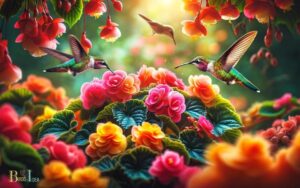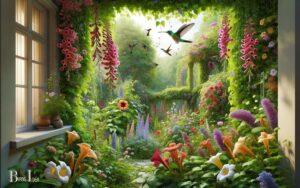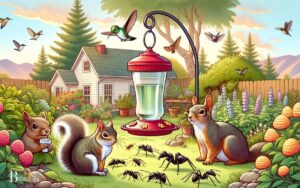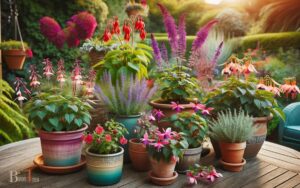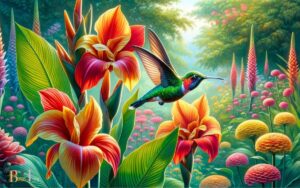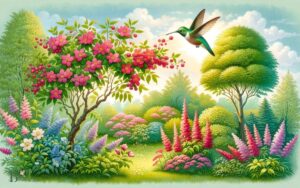Shrubs That Attract Hummingbirds and Butterflies: Explore!
Shrubs such as Butterfly Bush (Buddleia), Weigela, and Azaleas are excellent choices for gardeners looking to attract hummingbirds and butterflies.
These plants offer abundant nectar through their vibrant flowers, providing essential food sources for these pollinators.
Attracting hummingbirds and butterflies to your garden not only adds beauty and interest but also contributes to the health of your local ecosystem by supporting pollination.
To create a habitat that appeals to these creatures, consider planting the following types of shrubs:
These shrubs thrive in well-drained soil and prefer locations that receive full to partial sunlight. Regular watering and occasional pruning to encourage new growth and more blooms can also be beneficial.
Enhance your garden’s appeal to wildlife by incorporating shrubs like Butterfly Bush and Azaleas, which offer a feast for the eyes and nourishment for hummingbirds and butterflies.
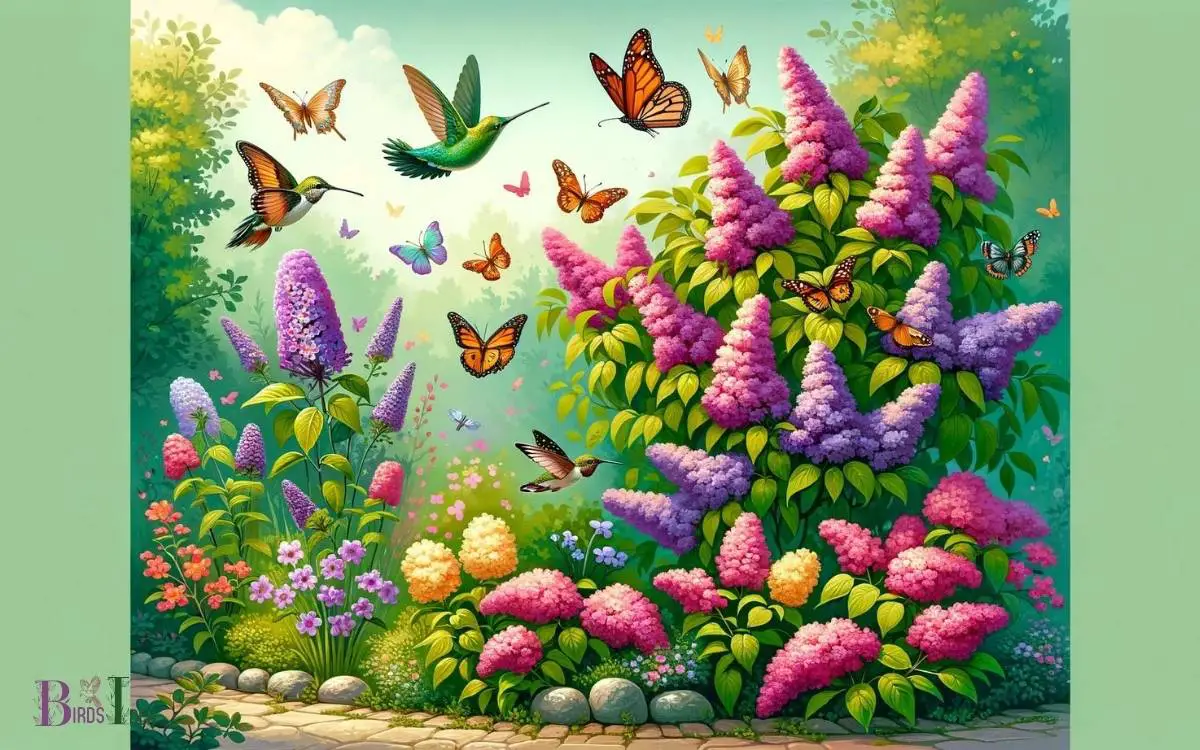
Key Takeaway
Choosing the Right Shrubs
When choosing the right shrubs to attract hummingbirds and butterflies, it’s important to consider their preferred nectar-producing varieties.
Hummingbirds are drawn to brightly colored tubular flowers such as Weigela, Butterfly Bush, and Honeysuckle, while butterflies seek out flat-topped clusters like those found on Buddleia, Lilac, and Potentilla.
These shrubs not only provide nectar but also act as host plants for butterfly larvae. It’s crucial to select shrubs that bloom at different times throughout the season to ensure a continuous nectar supply.
Additionally, opting for native shrub species is beneficial as they are well-adapted to the local climate and soil, making them easier to maintain. By choosing the right shrubs, one can create an inviting and sustainable habitat for these beautiful, delicate creatures.
Sunlight and Soil Requirements
Some shrubs that attract hummingbirds and butterflies require specific sunlight and soil conditions for optimal growth and nectar production. Understanding these requirements can help gardeners choose the right shrubs for their garden.
Below is a table detailing the sunlight and soil requirements for popular shrubs that attract hummingbirds and butterflies:
| Shrubs | Sunlight | Soil |
|---|---|---|
| Butterfly Bush | Full sun | Well-drained, fertile |
| Trumpet Vine | Full sun to part shade | Well-drained, average |
| Coral Honeysuckle | Full sun to part shade | Well-drained, moist |
Flowering Seasons
The flowering seasons of shrubs play a crucial role in attracting hummingbirds and butterflies to the garden. Understanding the ideal blooming times and seasonal flower varieties is essential for creating a habitat that appeals to these beautiful creatures.
By focusing on the specific flowering seasons, gardeners can ensure a continuous and diverse source of nectar for hummingbirds and butterflies throughout the year.
Ideal Blooming Times
One can find shrubs that attract hummingbirds and butterflies in various blooming times throughout the year.
Understanding the ideal blooming times for these shrubs can help gardeners plan their landscapes to provide continuous food sources for these beautiful creatures.
- Spring: Many shrubs bloom in spring, providing early nectar sources as hummingbirds and butterflies emerge from winter hibernation.
- Summer: Numerous shrubs bloom in summer, coinciding with the peak activity of hummingbirds and butterflies. These blooming shrubs offer sustenance during the warm months.
- Fall: Some shrubs bloom in fall, offering essential nectar as hummingbirds and butterflies prepare for migration or seek nourishment before winter hibernation.
Seasonal Flower Varieties
Blossoming at different times of the year, shrubs that attract hummingbirds and butterflies offer a diverse array of seasonal flower varieties.
In spring, plants like azaleas, butterfly bushes, and weigelas burst into colorful blooms, attracting these delightful creatures as they begin their seasonal activities.
During the summer months, shrubs such as butterfly weed, abelia, and potentilla showcase their vibrant and nectar-rich flowers, providing a vital food source for hummingbirds and butterflies.
As fall approaches, shrubs like beautyberry and Russian sage continue to provide a rich nectar source, extending the availability of food for these pollinators as they prepare for the coming winter.
Understanding the flowering seasons of these shrubs enables gardeners to create a continuous supply of nectar-rich blooms, ensuring that hummingbirds and butterflies have sustenance throughout the year.
Nectar-Rich Varieties
Attracting hummingbirds and butterflies, nectar-rich shrubs provide a vital food source for these delicate creatures.
Gardeners seeking to attract these beautiful pollinators should consider planting nectar-rich varieties. These shrubs not only offer sustenance but also add vibrant colors and fragrances to the garden.
Here are three nectar-rich shrubs that are particularly beloved by hummingbirds and butterflies:
- Butterfly Bush (Buddleja davidii): This shrub produces clusters of nectar-rich flowers that are irresistible to butterflies, especially monarchs and swallowtails.
- Weigela (Weigela florida): With its trumpet-shaped flowers, Weigela is a favorite of hummingbirds and butterflies alike.
- Lantana (Lantana camara): Lantana’s colorful blooms and sweet nectar attract both hummingbirds and butterflies, making it a wonderful addition to any pollinator garden.
Maintenance and Pruning
When it comes to maintaining shrubs that attract hummingbirds and butterflies, proper pruning techniques are essential. Understanding the timing for maintenance and encouraging healthy growth are also key points to consider.
By following these maintenance and pruning tips, one can create an environment that is conducive to attracting and supporting these beautiful creatures.
Proper Pruning Techniques
Proper pruning techniques for shrubs that attract hummingbirds and butterflies ensure healthy growth and abundant nectar sources.
To maintain the health and attractiveness of these plants, individuals should follow these key pruning guidelines:
- Regular Inspection: Check shrubs for dead or diseased branches, and promptly remove them to prevent the spread of disease and encourage new growth.
- Selective Pruning: Trim back overgrown or tangled branches to improve air circulation and sunlight penetration, promoting overall plant health and vigor.
- Timing: Prune shrubs during their dormant season to minimize stress on the plants and maximize the potential for new growth and blooming.
By applying these techniques, individuals can help ensure that their shrubs provide an optimal environment for hummingbirds and butterflies. Proper pruning sets the stage for healthy, vibrant plants that attract and support these delicate and beautiful creatures.
Timing for Maintenance
During the dormant season, individuals should carefully schedule maintenance and pruning activities for shrubs that attract hummingbirds and butterflies to minimize stress on the plants and promote optimal growth.
It’s essential to conduct maintenance and pruning during the dormant season to avoid disrupting the blooming and nesting periods of hummingbirds and butterflies.
This timing allows the shrubs to recover without impeding their ability to attract and support these beautiful creatures.
Additionally, pruning during dormancy helps maintain the shape and size of the shrubs, ensuring they remain attractive and functional for the coming seasons.
By being mindful of the timing for maintenance and pruning, individuals can create a welcoming and nourishing environment for hummingbirds and butterflies while also promoting the overall health and vitality of the shrubs.
Encouraging Healthy Growth
To ensure healthy growth through maintenance and pruning, individuals should carefully consider the timing for these activities, aiming to minimize stress on the shrubs and support their ability to attract and nourish hummingbirds and butterflies.
Here are three essential tips for encouraging healthy growth:
- Regular Pruning: Regularly prune dead or damaged branches to promote new growth and maintain the shrub’s shape. This practice also helps improve air circulation and sunlight exposure, which are crucial for the overall health of the shrub.
- Proper Timing: It’s important to prune shrubs at the right time to avoid interfering with their blooming and fruiting cycles. Research the specific shrub species to determine the best time for pruning without disrupting its natural growth patterns.
- Healthy Maintenance Practices: In addition to pruning, proper maintenance such as watering, fertilizing, and controlling pests and diseases is vital for supporting the shrub’s overall health and encouraging robust growth.
Companion Planting
Many gardeners use companion planting to naturally control pests and promote healthy growth in their shrubs. By strategically planting certain shrubs together, gardeners can take advantage of the natural properties of different plants to create a balanced ecosystem.
For example, planting fragrant herbs like lavender and rosemary near shrubs can help repel pests, while also attracting beneficial insects like butterflies.
Additionally, planting nitrogen-fixing plants like clover near shrubs can help improve the soil quality and promote healthier growth.
Some shrubs, like butterfly bush and bee balm, also work well with other plants to create a habitat that attracts hummingbirds and butterflies.
Understanding which plants work well together and how they can benefit each other is key to successful companion planting in a hummingbird and butterfly garden.
Attracting Hummingbirds
Attracting hummingbirds requires selecting shrubs with vibrant, trumpet-shaped flowers that are rich in nectar. These tiny birds are attracted to specific types of flowers, and planting the right shrubs can help create an inviting environment for them.
- Native Shrubs: Choose native shrubs that produce flowers in shades of red, orange, and pink, as these colors are particularly attractive to hummingbirds.
- Continuous Bloom: Select shrubs that bloom at different times throughout the growing season to provide a consistent nectar source for hummingbirds.
- Low-Maintenance Shrubs: Opt for low-maintenance shrubs that are easy to care for and are hardy in your specific climate, ensuring a long-term habitat for hummingbirds.
Attracting Butterflies
When considering shrubs that attract butterflies, it is essential to select varieties with brightly colored flowers and ample nectar to entice these delicate creatures. Butterflies are attracted to vibrant colors such as red, orange, yellow, pink, and purple.
Additionally, they are drawn to specific types of flowers such as butterfly bush, milkweed, coneflower, and butterfly weed, as these plants provide the necessary nectar and serve as host plants for butterfly larvae.
The table below highlights some shrubs and their characteristics that can help in attracting butterflies:
| Shrubs | Flower Color | Nectar Production | Butterfly Attraction |
|---|---|---|---|
| Butterfly Bush | Purple, Pink | High | High |
| Milkweed | Pink, Orange | High | High |
| Coneflower | Purple, Pink | Moderate | Moderate |
| Butterfly Weed | Orange, Red | High | High |
Conclusion
By planting nectar-rich shrubs and creating a welcoming environment for hummingbirds and butterflies, gardeners can bring a touch of magic to their outdoor spaces.
These winged beauties will flit and flutter among the vibrant blooms, adding a sense of joy and wonder to the garden.
With the right combination of shrubs, sunlight, and maintenance, anyone can create a haven for these delightful creatures to thrive and bring life to the garden.

